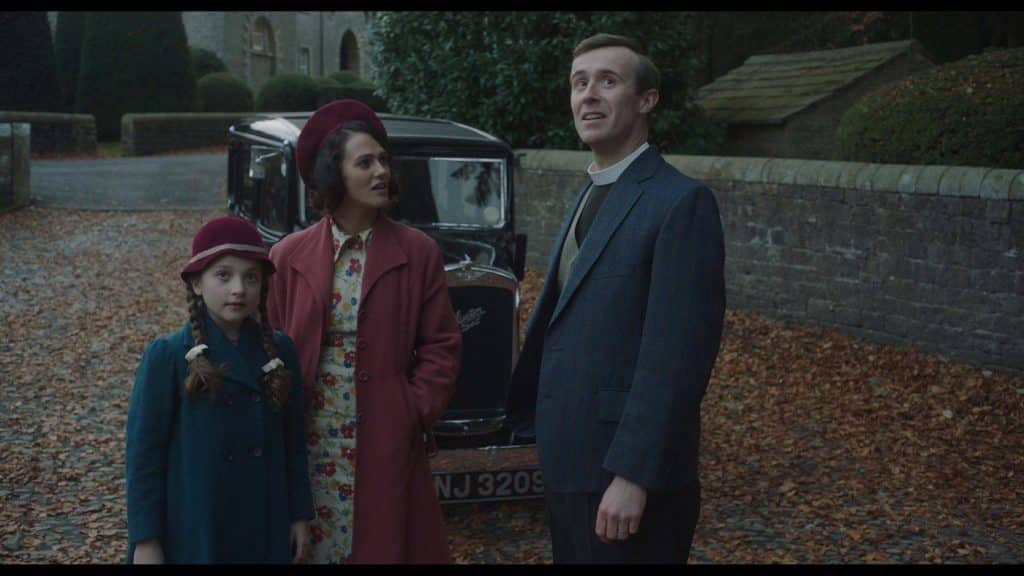Despite its high quality production design and strong performances, the Shudder haunted house flick lacks in genuine thrills
Masked killers lose their popularity, vampires come and go, but haunted houses are forever. There will always be an audience for movies in which families are driven out of their homes by diabolical forces, especially if that home is built on a Native American burial ground, or the site of a mass murder. Shudder’s latest The Banishing has all the necessary components of a good haunted house movie, with luxurious set design and actors who are taking it all very seriously, but its dearth of any real scares keeps it from truly taking off.
Loosely inspired by the real-life haunting of a rectory in the English countryside, The Banishing takes place in the period leading up to England’s entry into World War II. Marianne (Jessica Brown Findlay), a young woman with a never explained but oft-alluded to checkered past, arrives at a village rectory with her young daughter, Adelaide (Anya McKenna-Bruce), to live with her husband, Linus (John Heffernan), the new vicar, who’s settled in ahead of them. Despite not seeing each other for a while, Marianne and Linus’s reception towards each other is cool at best. Linus has all the sexual energy of a damp sock, but also bristles with resentment whenever Marianne so much as makes idle conversation with other men in the village.
That turns out to be the least of Marianne’s problems, however. Strange things are afoot in the rectory, things that every single other person in town except Linus and Marianne knows about, but, at the order of sinister Bishop Malachi (John Lynch), must keep a secret. Adelaide begins acting strangely, Marianne hears unexplained noises in the night, and she spies hooded figures lurking around the rectory. The only person willing to help is Harry Price (Sean Harris), a psychic who’s also the town drunk, but he’s more useful than Linus, who folds like a cheap card table in the face of adversity.
Lingering over everything is a different kind of spectre, as the rise of fascism makes it no longer possible to live a life blessedly free of having to choose sides. Bishop Malachi is a man of many secrets, not just what it is that drives the rectory ghosts to torment anyone who tries to live there.
[It] has all the necessary components of a good haunted house movie…but its dearth of any real scares keeps it from truly taking off.
The Banishing checks off all the standard boxes of a haunted house movie: house where Something Terrible once happened, creepy dolls, spooky games of hide and seek, malevolent mirror images, dank basements, disembodied voices, old books with strange markings in them. However, if you’re looking for the kind of scares that movies like The Conjuring and Poltergeist offer, you won’t find them here. If director Christopher Smith was trying to go for a classic gothic ghost story, where mood is more important than action, then he certainly succeeded. The dimly lit hallways of Morley Rectory offer all sorts of opportunities for the audience to see things that aren’t really there. However, it’s a bit too understated at times, to the point where by fifty minutes in and nothing’s really happened yet, you might be wondering where it’s going, and if it’s worth the remaining time.
Even a scene in which Harry is beaten up for knowing too much is shot at a tasteful distance. Smith has made solid horror movies before (Creep, Severance), and while The Banishing is more than competently made, it feels as though it’s a little embarrassed of itself. Trying to add some narrative weight and relevance by setting it against the rise of Hitler isn’t really necessary (and, as it turns out, not really relevant to the underlying cause of the haunting). In trying not to make something too lurid and campy, it swings too far in the other direction and becomes dry, and, frankly, a little dull.

Screenwriters David Beton, Ray Bogdanovich, and Dean Lines make the mistake of rendering a subplot more interesting than the main story. I didn’t care so much about the ghost story as I did trying to figure out how Marianne and Linus became a married couple. The colorful robes and nightclothes Marianne wears suggests she once lived a life far more interesting than the one she lives now as a vicar’s wife, so how did they get together? They’re clearly not attracted to each other, they have nothing in common, they don’t even seem to like each other very much. Linus treats her and Adelaide’s arrival at the rectory as an inconvenience, and when they begin reacting to the supernatural events happening around them, his sole response is chilly annoyance.
One could suggest, as is often a trope in haunted house movies, that it’s the diabolical forces in the house that are making them act in such a way towards each other, but it’s broadly hinted that the gulf between them formed long before Marianne arrived at Morley Rectory. Exploring this further is a regrettable missed opportunity. Regardless, Linus may go down as one of horror’s great ineffectual husbands, spending most of his time grimacing and making passive-aggressive remarks about Marianne’s past. In some ways he’s more loathsome than the openly evil Bishop Malachi.
Make no mistake, a great deal of care went into setting the scene and tone for The Banishing. The actors, particularly Findlay and Lynch, give it some gravitas that a lot of horror movies lack. It wants very much to be a spooky story for grown-ups, and it almost works. It just needs to actually be spooky.
The Banishing premieres on Shudder April 15th.